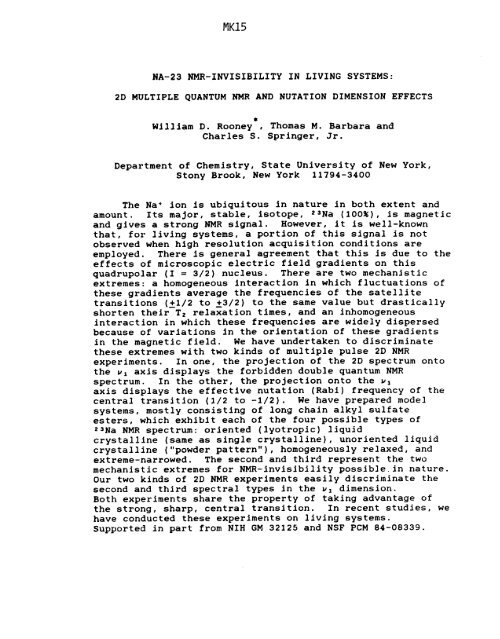th - 1987 - 51st ENC Conference
th - 1987 - 51st ENC Conference
th - 1987 - 51st ENC Conference
You also want an ePaper? Increase the reach of your titles
YUMPU automatically turns print PDFs into web optimized ePapers that Google loves.
MKI5<br />
NA-23 NMR-INVISIBILITY IN LIVING SYSTEMS:<br />
2D MULTIPLE QUANTUM NMR AND NUTATION DIMENSION EFFECTS<br />
S<br />
William D. Rooney , Thomas M. Barbara and<br />
Charles S. Springer, Jr.<br />
Department of Chemistry, State University of New York,<br />
Stony Brook, New York 11794-3400<br />
The Na + ion is ubiquitous in nature in bo<strong>th</strong> extent and<br />
amount. Its major, stable, isotope, 23Na (I00%), is magnetic<br />
and gives a strong NMR signal. However, It is well-known<br />
<strong>th</strong>at, for living systems, a portion of <strong>th</strong>is signal is not<br />
observed when high resolution acquisition conditions are<br />
employed. There is general agreement <strong>th</strong>at <strong>th</strong>is is due to <strong>th</strong>e<br />
effects of microscopic electric field gradients on <strong>th</strong>is<br />
quadrupolar (I = 3/2) nucleus. There are two mechanistic<br />
extremes: a homogeneous interaction in which fluctuations of<br />
<strong>th</strong>ese gradients average <strong>th</strong>e frequencies of <strong>th</strong>e satellite<br />
transitions (~i/2 to ~3/2) to <strong>th</strong>e same value but drastically<br />
shorten <strong>th</strong>eir T2 relaxation times, and an inhomogeneous<br />
interaction in which <strong>th</strong>ese frequencies are widely dispersed<br />
because of variations in <strong>th</strong>e orientation of <strong>th</strong>ese gradients<br />
in <strong>th</strong>e magnetic field. We have undertaken to discriminate<br />
<strong>th</strong>ese extremes wi<strong>th</strong> two kinds of multiple pulse 2D NMR<br />
experiments. In one, <strong>th</strong>e projection of <strong>th</strong>e 2D spectrum onto<br />
<strong>th</strong>e v, axis displays <strong>th</strong>e forbidden double quantum NMR<br />
spectrum. In <strong>th</strong>e o<strong>th</strong>er, <strong>th</strong>e projection onto <strong>th</strong>e wl<br />
axis displays <strong>th</strong>e effective nutatlon (Rabi) frequency of <strong>th</strong>e<br />
central transition (I/2 to -I/2). We have prepared mode]<br />
systems, mostly consisting of long chain alkyl sulfate<br />
esters, which exhibit each of <strong>th</strong>e four possible types of<br />
23Na NMR spectrum: oriented (lyotropic) liquid<br />
crystalline (same as single crystalline), unoriented liquid<br />
crystalline ("powder pattern"), homogeneously relaxed, and<br />
extreme-narrowed. The second and <strong>th</strong>ird represent <strong>th</strong>e two<br />
mechanistic extremes for NMR-invisibility possible in nature.<br />
Our two kinds of 2D NMR experiments easily discriminate <strong>th</strong>e<br />
second and <strong>th</strong>ird spectral types in <strong>th</strong>e ~2 dimension.<br />
Bo<strong>th</strong> experiments share <strong>th</strong>e property of taking advantage of<br />
<strong>th</strong>e strong, sharp, central transition. In recent studies, we<br />
have conducted <strong>th</strong>ese experiments on living systems.<br />
Supported in part from NIH GM 32125 and NSF PCM 84-08339.













